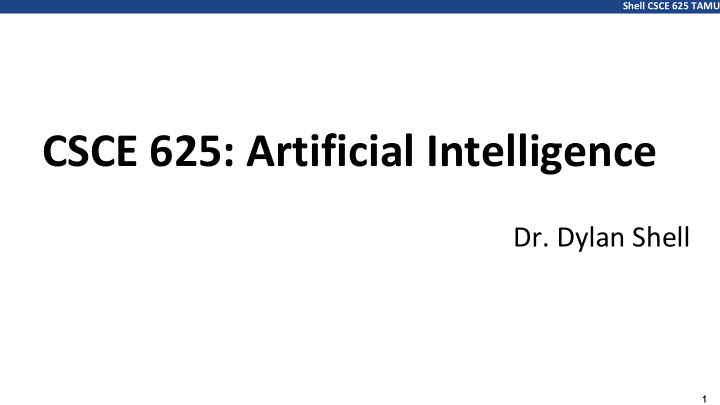



Shell CSCE 625 TAMU CSCE 625: Artificial Intelligence Dr. Dylan Shell 1
Shell CSCE 625 TAMU CSCE 625: Artificial Intelligence ● Course Homepage http://robotics.cs.tamu.edu/dshell/cs625/ ● Textbook Artificial Intelligence: A Modern Approach, 3rd Edition by Stuart Russell and Peter Norvig, 2009 Infinitesimal Calculus by James M. Henle and Eugene M. Kleinberg, 1979 ● Other Reading Material: See the course homepage 2
Shell CSCE 625 TAMU Objectives ⬛ Understand and enumerate the basic techniques for creating intelligent programs. ⬛ Create a successful program illustrating the operation of one of these methods. ⬛ Apply the right programming language or technique to the right problem and be able to evaluate a proposed AI application for likelihood of success. ⬛ Be able to discern sensationalism from science on the possible impact of AI on society. 3
Shell CSCE 625 TAMU Different definitions of the discipline A.I ⬛ “New” problems? Things on the fringe? ⬛ Is it just algorithms for difficult problems? ⬛ Is it just heuristic control theory, but light on theory? 4
Shell CSCE 625 TAMU Paraphrasing H. S. Wall: Uppermost in the minds of the professors is the desire to help the student develop the ability to set up and solve problems, and to make free use of computing. I believe progress can be made in that direction. Perhaps the fault lies in the prevalent idea that the subject is a kit of tools all arranged in little packages. Over the years this has come to be reflected in our textbooks, which in trying to meet the demand for more and more tools in the kit, have reached the point where one can question whether we are teaching science at all. 5
Shell CSCE 625 TAMU Real Objectives ⬛ Give some indication of the intellectual activity of scientists. ▪ Characteristics of scientific procedures. ▪ Goals for which the scientist strives. ⬛ The new outlooks which the work gives for the great mysteries of human existence. ⬛ I want to get you to think critically and inquisitively. 6
Shell CSCE 625 TAMU 7
Shell CSCE 625 TAMU Creation Redux "It has often been said that a person does not really understand something until he teaches it to someone else. Actually a person does not really understand something until he can teach it to a computer ." -- Donald E. Knuth. 8
Shell CSCE 625 TAMU 9
Shell CSCE 625 TAMU Bloom’s Taxonomy 10
Shell CSCE 625 TAMU Our roles and respective responsibilities "I see my role as that of someone who opens a door to the riches of the world of mathematics and encourages the students to take responsibility for their own education. ...the standard pattern of the teacher as the sole source of initiative, and of the teacher-and-textbook combination as the sole source of wisdom, induces a condition of intellectual bondage; an umbilical cord is indispensable at the fetal stage of growth, but it must be cut if the next stage of growth is to take place." -- Abe Shenitzer 11
Shell CSCE 625 TAMU The Texas Method R.L. Moore, F.B Jones, H. J. Ettlinger, and H.S. Wall ⬛ Much attention is given to matters of language and logic. ⬛ To develop clear thinking, it is necessary to develop the ability to make statements that say exactly what is intende ⬛ Also, it is necessary to learn to deny statements. 12
Shell CSCE 625 TAMU The Texas Method “Examination systems, in spite of all efforts to the contrary, seem to influence our teaching in the direction of formalism rather than insight; because it is easy to test a student’s manipulative skill and extremely difficult to test their ability to think.” -- W. B. Carver 13
Shell CSCE 625 TAMU The Texas Method “The Great contribution of mathematics, pure or applied, is not rigor. It is ideas. Those are what our teaching should explain, and our own research should look for, and our writing should express” -- G. Strang 14
Shell CSCE 625 TAMU 15
Shell CSCE 625 TAMU Sources: Bloom’s Taxonomy http://ezsnips.squarespace.com/blooms-taxonomy/ 16
Recommend
More recommend